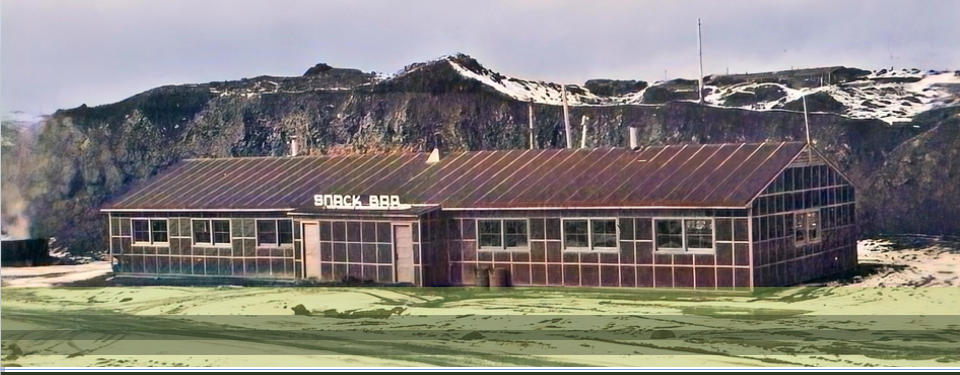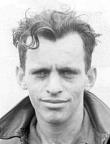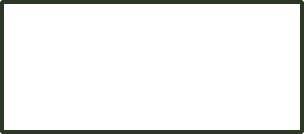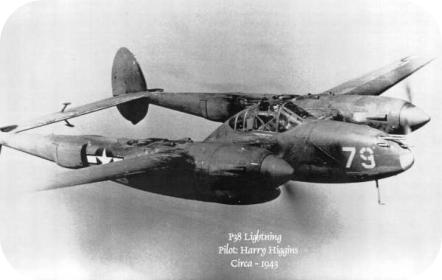

AMCHITKA

aka Ostrove Amchitka
Harry Higgins Amchitka Scrapbook
1943
On October 30, 1942 I was commissioned a 2nd Lieutenant, rated a pilot and married; all in three hours. Still
married to that same sweet girl. I flew P-38s with the 54th Fighter Squadron out of Amchitka. There were two
airfields on Amchitka; a short fighter strip at sea level in Constantine Harbor and a long bomber strip up on the
hill south and east of the harbor. The 'hill' was about 400 feet high. After driving the Japanese out of the Aleutians
I went home to Southern California where I instructed in P-38's and flew early jet fighters. After the war I went to
college on the GI Bill, then went to work for Boeing in aerodynamics, retired in '82. Still ride a bike, ski and fly. I
also have what is probably the best total roster of people in the outfit from 1942-1945. Get in touch if I can be of
any help!
[Note: Some of you may recognize Harry from his recent appearance on "The History Channel" presentation of "The Bloody
Aleutians."]
[UPDATE: Harry Clark Higgins passed away on the 30th of April, 2009. He will be missed.]


P38er@aol.com

Sixteen Mitsubishi 01 Betty bombers attacked Attu on May 22, 1943, the first such raid of the war. The weather prevented any
damage. The next day, May 23 (May 22 Japan time) six of us flew P-38's 250 miles from Amchitka to Attu, flying formation on our B-
24 navigational escort.
Lt. Col. James Watt, visiting from Fighter Command Headquarters in Anchorage, Led the flight. First Lt. Marshall Hyde had engine
trouble and fell out of formation. The other four pilots were Second Lts.; Fred Moore, Warren Banks, John Geddes and your
correspondent, Harry Higgins.
We were not completely surprised when the command post aboard the USS Pennsylvania gave us vectors on incoming bandits upon
our arrival over Attu.
It was a fine spring day in the Aleutians with nearly a solid overcast at 5,000 feet around Attu, which became broken to scattered as
we flew west of the island. I knew something was up when the drop tanks fell and Watt went to fill stink, pulling his nose up into a
steep climb. I learned all the details of the engagement after landing back at Amchitka - my radio was on the blink and I heard none
of the exciting conversations for the next half hour.
The use of full throttles tended to break up what had been a tight formation. Climbing through the broken clouds I spied the 16
Betty's in close line-abreast formation high above. Having seen us, they had abandoned their attack on Attu and were headed back
to Paramushiro, 750 miles west. While climbing I saw the amazing sight of their jettisoned bomb load exploding on the surface of the
ocean.
Pulling abreast of the Japanese formation, I test fired my guns and was dismayed to find my 20mm cannon inoperative. Its high
explosive head was much more effective than the lead 50 caliber slugs. We had been briefed that the Japanese had 20mm in their
tail turrets. I have learned recently that they may have had a second 20mm in the waist turret.
On my first pass I learned why they were flying line-abreast. As I sucked in behind their tails in my curve-of-pursuit I was facing
sixteen 20mm cannons, all firing huge tracers at my fragile body.
It was pretty exciting and my memory isn't clear about all the passes I made except the first and the last. I do recall seeing a P-38 in
a big barrel-roll during the heat of the battle and I thought, "This guy is enjoying himself too much!"
It was probably Warren Banks.
The Japanese were slowly descending and taking advantage of any clouds on the path. I recall seeing one of the bombers in a slow
spiral with dense smoke trailing one nacelle.
My last pass was spectacular. The fight had moved far to the west into nearly clear air with a few fair weather cumulus clouds here
and there. As I tried to work forward for a high side attack the formation disappeared into a cloud. Continuing to climb, I entered the
cloud behind them. When we all emerged I found myself directly above the bombers. I rolled over and dove on the leader, getting a
long burst into him. I then found myself in a screaming dive with the North Pacific looking awfully close.
After recovering, I looked around and saw 12 Betty's and no P-38's. At this point I was feeling pretty lonesome and far from home. I
was 350 miles from the nearest landing field and had been on full throttle for more than half an hour.
I waved goodbye to my new acquaintances in the Betty's and headed east. Below the clouds the horizon was blue water in all
directions. I tuned my Detrola set (a low frequency radio range receiver) hoping to pick up the Attu range station. Nothing. I later
learned that all the navigational radios were off the air to prevent the Japanese using them.
I recalled the sun had been on my left wing leaving Attu so I put it on my right wing, throttled back to best cruise and leaned the
engines.
My precision navigation paid off when Aggatu (30 miles south of Attu) hove up over the eastern horizon. It was an easy shot to
Massacre Bay on Attu our Liberator was circling. Feeling pretty good about not being lost anymore, I did a big victory roll in front of
the Lib and headed east for Amchitka.
I had my lunch laid out on my lap when I did this roll and the pumpkin pie and canteen of lemonade went flying around the cockpit
making a big mess and adding a little slapstick humor.
I flew back to Amchitka alone, leaning the engines a little more every now and then. The fuel lasted to get me home. There I learned
that Watt was missing and Geddes had been shot down but was able to belly in at Massacre Bay on Attu and was saved by the USN.
SOME THINGS I HAVE LEARNED ABOUT
THIS RAID IN RECENT YEARS
Lt. Col. WATT
I believe Col. Watt was shot down on his first pass. There was disagreement about whether he had got a message off after he was
shot. I met Carole Watt Collins, Col. Watts daughter between flights at Seatac Airport in the spring of 1998. She had been a babe in
arms on December 7, 1941 living in Hawaii where her father was a P-40 pilot. She and her mother were evacuated to the mainland
after the Pearl Harbor attack and never saw Col. Watt again. Her mother was bitter about losing her husband and closed her mind to
the wartime experiences.
In 1998 Carole had been in Alaska searching for stories about her dad. She picked my phone number up somewhere and when she
and her husband flew through Seattle we met and I gave her a copy of my file about the raid and spent an hour talking with her at the
airport. She told me this was the first real information she had ever had about her father.
Second Lieutenants don’t pal around with Lt. Cols. (*) and I didn’t know Col. Watt personally. Talking about him after the raid I
learned that he had been at Pearl during the big raid and had tried to get a P-40 in the air but was strafed or somehow prevented from
flying by the Japanese. The story was that he was very bitter about this and was most anxious to get at the enemy.
JOHN GEDDES AND RICHARD GREENE
John was shot down by the Japanese during the raid and landed his damaged P-38 in Massacre Bay, Attu. A USN OS2U Kingfisher
floatplane landed near John and the observer in the rear seat, Richard Greene, climbed down on the float and fished John out of the
drink. I introduced John to Richard on May 23, 1996; 53 years to the day after Richard saved John's life. This was a very emotional
experience. Richard had a gun shop and firing range back in the woods at the north end of Whidbey Island. He died in 1998 and he
was a great guy. Frances and I have become good friends with Jackie Greene, Richard’s widow. We see her now and then.
WARREN BANKS
I am pretty sure it was Warren Banks who did that slow roll just to irritate the Japanese in the middle of that big air battle. In 1998 Bill
Duffy, a 54th Fighter Squadron veteran, told me of Warren's last flight. Late in the afternoon one day in December, 1943 Bill and
Warren were scrambled out of Alexai Point on Attu to look for a surface vessel in trouble north of Attu. They never found the ship
but flew a bad heading trying to get home. In the dark of the night, low on fuel, they finally got their bearings and found Attu. But the
island was under the clouds and they were on top. Someone on the ground had the bright idea of shining a searchlight vertically
over Alexai Point. Bill spotted the light in the cloud. He spiraled down but lost Warren in the wild descent. With a lot of luck, Bill
made it ok but Warren was never seen again.
MARSHALL HYDE
Marsh was on the flight that morning but he had engine trouble and never got into the fight. He is living today near Pensacola,
Florida.
FREDERICK MOORE
I have lost Fred's address. He has not attended any of the squadron reunions.
H. C. Higgins
* In 1943 the enlisted men of the Fighting 54th, the 54th Fighter Squadron, had a dog named Rags. He had little to do with officers (I
was a second louie flying P-38's against Kiska and Attu back then). Rags made it up to Tech Sgt when a lady (?) dog showed up and
he was busted back to Pvt.


Current Update: 30 October 2021 12:29
Last Updated: 04 January 2013 12:01
Originally published 30 June 2001.



Amchitka

aka Ostrove Amchitka
Harry Higgins Amchitka
Scrapbook
1943
On October 30, 1942 I was commissioned a 2nd Lieutenant, rated a pilot and
married; all in three hours. Still married to that same
sweet girl. I flew P-38s with the 54th Fighter Squadron
out of Amchitka. There were two airfields on Amchitka;
a short fighter strip at sea level in Constantine Harbor
and a long bomber strip up on the hill south and east
of the harbor. The 'hill' was about 400 feet high. After
driving the Japanese out of the Aleutians I went home
to Southern California where I instructed in P-38's and
flew early jet fighters. After the war I went to college on
the GI Bill, then went to work for Boeing in
aerodynamics, retired in '82. Still ride a bike, ski and
fly. I also have what is probably the best total roster of
people in the outfit from 1942-1945. Get in touch if I
can be of any help!
[Note: Some of you may recognize Harry from his recent appearance on
"The History Channel" presentation of "The Bloody Aleutians."]
[UPDATE: Harry Clark Higgins passed away on the 30th of April, 2009. He
will be missed.]


P38er@aol.com

Sixteen Mitsubishi 01 Betty bombers attacked Attu on May 22, 1943, the
first such raid of the war. The weather prevented any damage. The next
day, May 23 (May 22 Japan time) six of us flew P-38's 250 miles from
Amchitka to Attu, flying formation on our B-24 navigational escort.
Lt. Col. James Watt, visiting from Fighter Command Headquarters in
Anchorage, Led the flight. First Lt. Marshall Hyde had engine trouble and
fell out of formation. The other four pilots were Second Lts.; Fred Moore,
Warren Banks, John Geddes and your correspondent, Harry Higgins.
We were not completely surprised when the command post aboard the USS
Pennsylvania gave us vectors on incoming bandits upon our arrival over
Attu.
It was a fine spring day in the Aleutians with nearly a solid overcast at
5,000 feet around Attu, which became broken to scattered as we flew west
of the island. I knew something was up when the drop tanks fell and Watt
went to fill stink, pulling his nose up into a steep climb. I learned all the
details of the engagement after landing back at Amchitka - my radio was on
the blink and I heard none of the exciting conversations for the next half
hour.
The use of full throttles tended to break up what had been a tight formation.
Climbing through the broken clouds I spied the 16 Betty's in close line-
abreast formation high above. Having seen us, they had abandoned their
attack on Attu and were headed back to Paramushiro, 750 miles west.
While climbing I saw the amazing sight of their jettisoned bomb load
exploding on the surface of the ocean.
Pulling abreast of the Japanese formation, I test fired my guns and was
dismayed to find my 20mm cannon inoperative. Its high explosive head
was much more effective than the lead 50 caliber slugs. We had been
briefed that the Japanese had 20mm in their tail turrets. I have learned
recently that they may have had a second 20mm in the waist turret.
On my first pass I learned why they were flying line-abreast. As I sucked in
behind their tails in my curve-of-pursuit I was facing sixteen 20mm
cannons, all firing huge tracers at my fragile body.
It was pretty exciting and my memory isn't clear about all the passes I
made except the first and the last. I do recall seeing a P-38 in a big barrel-
roll during the heat of the battle and I thought, "This guy is enjoying
himself too much!"
It was probably Warren Banks.
The Japanese were slowly descending and taking advantage of any clouds
on the path. I recall seeing one of the bombers in a slow spiral with dense
smoke trailing one nacelle.
My last pass was spectacular. The fight had moved far to the west into
nearly clear air with a few fair weather cumulus clouds here and there. As I
tried to work forward for a high side attack the formation disappeared into
a cloud. Continuing to climb, I entered the cloud behind them. When we all
emerged I found myself directly above the bombers. I rolled over and dove
on the leader, getting a long burst into him. I then found myself in a
screaming dive with the North Pacific looking awfully close.
After recovering, I looked around and saw 12 Betty's and no P-38's. At this
point I was feeling pretty lonesome and far from home. I was 350 miles
from the nearest landing field and had been on full throttle for more than
half an hour.
I waved goodbye to my new acquaintances in the Betty's and headed east.
Below the clouds the horizon was blue water in all directions. I tuned my
Detrola set (a low frequency radio range receiver) hoping to pick up the
Attu range station. Nothing. I later learned that all the navigational radios
were off the air to prevent the Japanese using them.
I recalled the sun had been on my left wing leaving Attu so I put it on my
right wing, throttled back to best cruise and leaned the engines.
My precision navigation paid off when Aggatu (30 miles south of Attu) hove
up over the eastern horizon. It was an easy shot to Massacre Bay on Attu
our Liberator was circling. Feeling pretty good about not being lost
anymore, I did a big victory roll in front of the Lib and headed east for
Amchitka.
I had my lunch laid out on my lap when I did this roll and the pumpkin pie
and canteen of lemonade went flying around the cockpit making a big mess
and adding a little slapstick humor.
I flew back to Amchitka alone, leaning the engines a little more every now
and then. The fuel lasted to get me home. There I learned that Watt was
missing and Geddes had been shot down but was able to belly in at
Massacre Bay on Attu and was saved by the USN.
SOME THINGS I HAVE LEARNED ABOUT
THIS RAID IN RECENT YEARS
Lt. Col. WATT
I believe Col. Watt was shot down on his first pass. There was
disagreement about whether he had got a message off after he was shot. I
met Carole Watt Collins, Col. Watts daughter between flights at Seatac
Airport in the spring of 1998. She had been a babe in arms on December 7,
1941 living in Hawaii where her father was a P-40 pilot. She and her mother
were evacuated to the mainland after the Pearl Harbor attack and never saw
Col. Watt again. Her mother was bitter about losing her husband and
closed her mind to the wartime experiences.
In 1998 Carole had been in Alaska searching for stories about her dad. She
picked my phone number up somewhere and when she and her husband
flew through Seattle we met and I gave her a copy of my file about the raid
and spent an hour talking with her at the airport. She told me this was the
first real information she had ever had about her father.
Second Lieutenants don’t pal around with Lt. Cols. (*) and I didn’t know
Col. Watt personally. Talking about him after the raid I learned that he had
been at Pearl during the big raid and had tried to get a P-40 in the air but
was strafed or somehow prevented from flying by the Japanese. The story
was that he was very bitter about this and was most anxious to get at the
enemy.
JOHN GEDDES AND RICHARD GREENE
John was shot down by the Japanese during the raid and landed his
damaged P-38 in Massacre Bay, Attu. A USN OS2U Kingfisher floatplane
landed near John and the observer in the rear seat, Richard Greene,
climbed down on the float and fished John out of the drink. I introduced
John to Richard on May 23, 1996; 53 years to the day after Richard saved
John's life. This was a very emotional experience. Richard had a gun shop
and firing range back in the woods at the north end of Whidbey Island. He
died in 1998 and he was a great guy. Frances and I have become good
friends with Jackie Greene, Richard’s widow. We see her now and then.
WARREN BANKS
I am pretty sure it was Warren Banks who did that slow roll just to irritate
the Japanese in the middle of that big air battle. In 1998 Bill Duffy, a 54th
Fighter Squadron veteran, told me of Warren's last flight. Late in the
afternoon one day in December, 1943 Bill and Warren were scrambled out
of Alexai Point on Attu to look for a surface vessel in trouble north of Attu.
They never found the ship but flew a bad heading trying to get home. In
the dark of the night, low on fuel, they finally got their bearings and found
Attu. But the island was under the clouds and they were on top. Someone
on the ground had the bright idea of shining a searchlight vertically over
Alexai Point. Bill spotted the light in the cloud. He spiraled down but lost
Warren in the wild descent. With a lot of luck, Bill made it ok but Warren
was never seen again.
MARSHALL HYDE
Marsh was on the flight that morning but he had engine trouble and never
got into the fight. He is living today near Pensacola, Florida.
FREDERICK MOORE
I have lost Fred's address. He has not attended any of the squadron
reunions.
H. C. Higgins
* In 1943 the enlisted men of the Fighting 54th, the 54th Fighter Squadron,
had a dog named Rags. He had little to do with officers (I was a second
louie flying P-38's against Kiska and Attu back then). Rags made it up to
Tech Sgt when a lady (?) dog showed up and he was busted back to Pvt.














